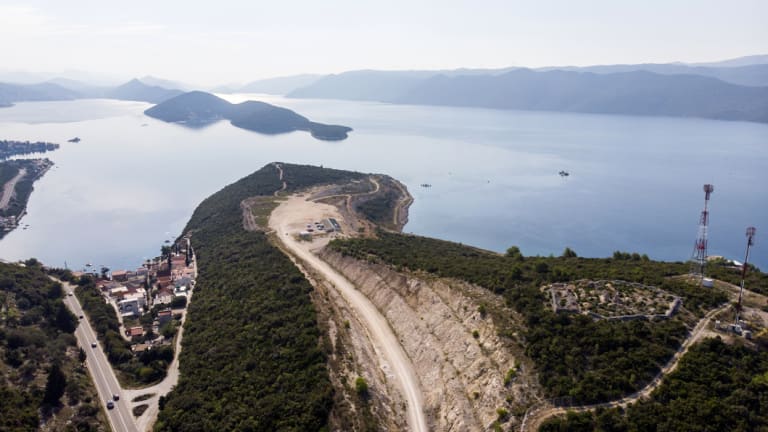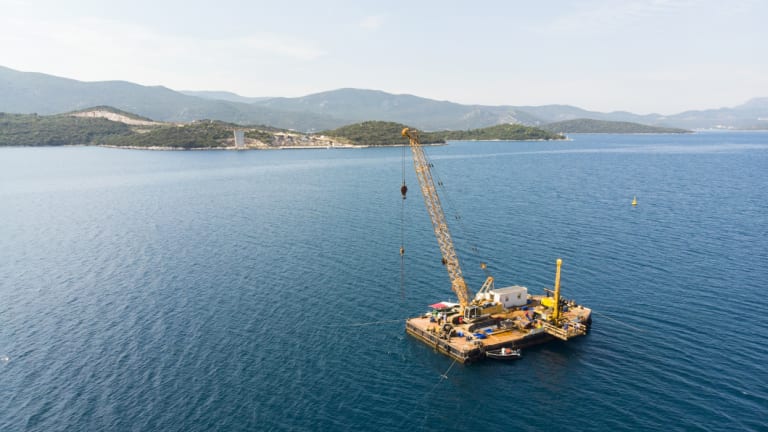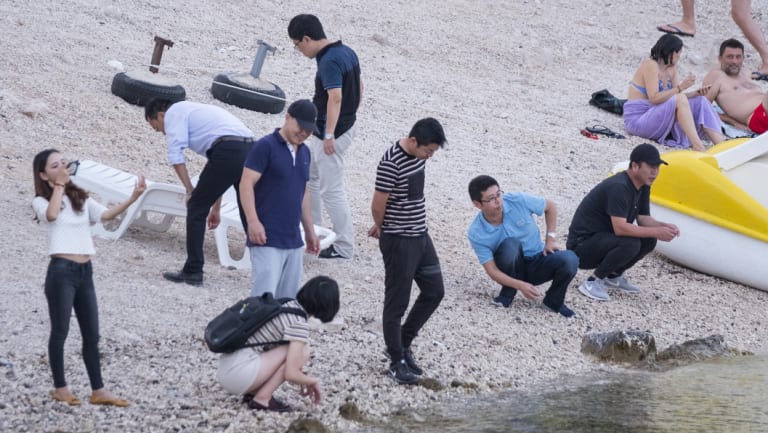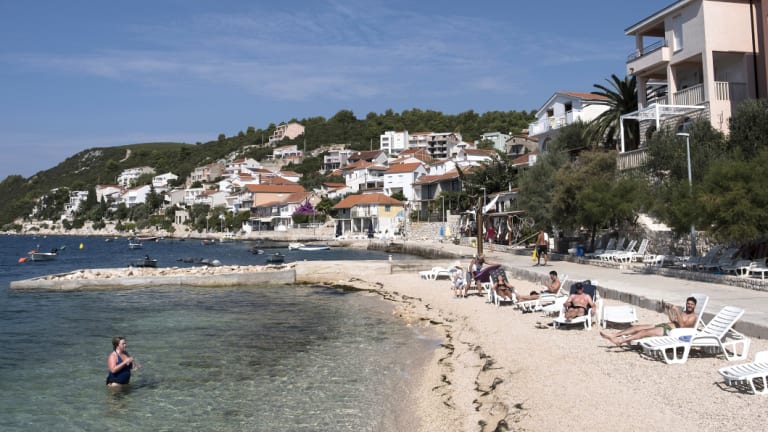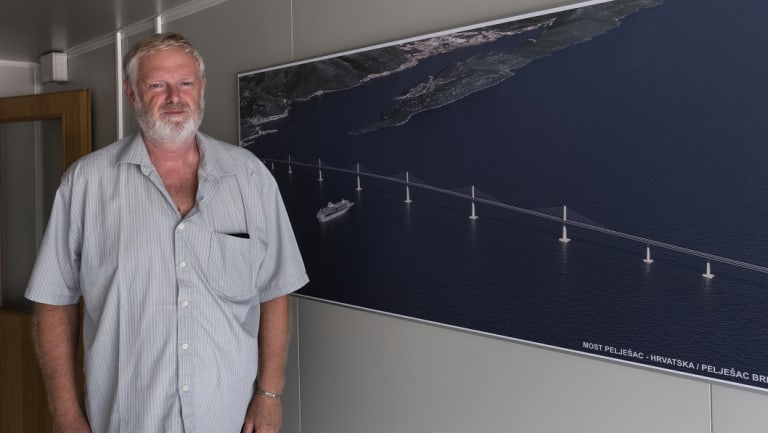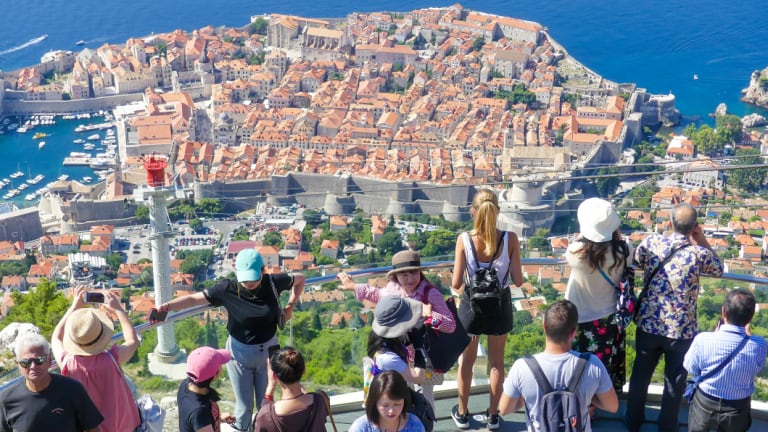Komarna, Croatia: As a quirk of history and the Balkan wars, a corner of Croatia is cut off from the rest of the country by a 3-kilometre interruption of land belonging to neighbouring Bosnia. It is a rift that Croatia has long wanted to repair with a bridge that would unite the disconnected sliver of its coast with the rest of the country.
A site where a bridge linking the city of Dubrovnik to the rest of Croatia will be built.Credit:New York Times
For decades — foiled by war, corruption, political bickering and global financial turmoil — work never got much further on the bridge than abandoned concrete pylons and two bronze angels overlooking the glittering waters of the Adriatic Sea.
That is, until the Chinese arrived in the northern summer.
With drills churning and its engineers arriving daily, a state-owned Chinese construction firm, the China Road and Bridge Corporation, is the latest company to take on the project.
For many Croatians, just the possibility that the long-awaited bridge project is on track to be completed is reason for celebration.
A platform works in the channel where the bridge will be built.Credit:New York Times
But the project is also a test case for the European Union, which has been wary of allowing state-owned Chinese firms into the market for big European infrastructure projects, fearing that Chinese companies can undermine competition, trample the bloc's labour laws and depress wages.
The bridge, which will span the water separating a peninsula in the disconnected region with the village of Komarna and the rest of Croatia, is the first time a project funded largely with European Union money has been won by a Chinese firm.
China Road and Bridge won the contract with a proposal that undercut the nearest competitor by nearly $US100 million ($140 million), leading to a legal challenge. The European Commission is also investigating whether Croatia awarded the contract in line with European Union rules.
On top of the concerns officials have over competitive practices and lower wages, many of the jobs that come with the project might not even go to workers in the slow-growing economies of Europe.
Chinese workers on a public beach in Komarna, Croatia, near the site where a bridge connecting Dubrovnik to the rest of Croatia will be built.Credit:New York Times
Typically, Chinese state firms bring most of their own workers for construction projects, an often contentious practice. It is not clear if Croatian authorities even know how much the Chinese workers will be paid. China Road and Bridge did not respond to queries, and Croatian authorities said they did not want to officially comment.
"European companies are increasingly finding themselves in the situation that they cannot compete with Chinese-subsidised companies on price levels," said Jens Bastian, an economic analyst who has detailed Chinese investments and loans in the Balkans in a report for the European Bank for Reconstruction and Development.
China is in the midst of a global infrastructure spending spree known as the Belt and Road Initiative, which is intended to increase Beijing's economic and diplomatic clout — but which is bringing rising criticism and scrutiny. China is actively cultivating leaders in the Balkans and Eastern Europe, an overture that some in the European Union regard as a veiled effort to undermine the bloc.
In a 2016 report, the European Union Institute for Security Studies concluded that the bloc may "have to acknowledge its limited leverage when it comes to influencing Chinese corporate behaviour."
Yet for Croatia, which joined the European Union in 2013, the project has become a neat and relatively cheap fix for a once insolvable problem in a Balkans region where bridges have long played outsize roles in politics and diplomacy.
When rulers sought to unite the region's ethnic and religious groups, bridges were built across rivers and over valley passes. When leaders wanted to divide people along ethnic lines, those same bridges were often fought over or destroyed to keep communities apart.
A beach in Komarna, Croatia.Credit:New York Times
Croatia was divided as part of the political agreement that ended the Balkan Wars. The Neum corridor, the strip of Bosnia's coastline that cuts Croatia in two, is Bosnia's only access to the Adriatic Sea. As things stand, people travelling from Croatia's southern coast must endure four border checkpoints to reach the rest of the country, which can mean delays of hours that disrupt one of the nation's chief economic drivers, tourism.
In June 2017, the European Union announced an allocation of €357 million ($581 million) — about 85 per cent of the bridge's cost — with a touch of fanfare.
"This project genuinely embodies our commitment to removing barriers, uniting territories and bringing people together," Corina Cretu, the union's commissioner for regional policy, said at the time.
Yet six months later, the situation became more complicated when Croatia awarded the project to China Road and Bridge. Rivals were furious. A Croatian court later dismissed a complaint from a losing bidder, Austrian-based Strabag, which accused the Chinese consortium of charging a price that was lower than the actual value of the project.
Jeroslav Segedin, civil engineer with Croatia Roads.Credit:New York Times
On a recent afternoon at the construction site, Jeroslav Segedin, a civil engineer, gave a tour of the early stages of the project. Segedin, a representative of Croatia Roads, which contracted with the Chinese company for the project, stressed the importance of the bridge, despite the concerns about Beijing's involvement.
"It means a lot to both Croatia and this region," he said. "It will be a national symbol for Croatia."
Segedin, whose team of civil engineers will oversee the project, said construction should reach its peak in about 18 months, when there are expected to be 490 workers on the bridge, most of them Chinese living in trailers on the sparsely populated peninsula. Croatian workers will take part in the construction, but only on a small scale.
European Union officials say they will be watching China's recruitment process for workers closely, once it gets underway, for possible violations of the bloc's labor laws. Even so, the Chinese have already been allowed to set the wages for the workers they bring to the site — something that European companies fear is an unfair advantage.
The uncertainty around how many Chinese workers will be employed at the site, and what they will be paid, has spawned rumours.
For months, the Croatian news media has been reporting that thousands of Chinese workers would be living on a cruise ship converted to a dormitory, overwhelming the small fishing village of Komarna where the construction site is based.
"It's incredible, the calls I've been getting regarding the Chinese workers in our region," said Smiljan Mustapic, the governor of the Slivno area where the bridge is being built. "It's like a group of aliens has landed."
For now, the bridge construction is focused under water and requires only a few dozen Chinese engineers.
Tourists enjoy the sites of Dubrovnik, Croatia.Credit:Shutterstock
Beyond the bridge project, China is seeking closer ties to Croatia in other ways, such as an agreement on joint police patrols — as was done in the heart of the old city of Dubrovnik this summer at the peak of tourism season.
The ostensible reason for the joint patrols was to help resolve issues related to Chinese tourists. But it also served as a dry run for Croatia's plans to host a meeting of the Chinese-led investment initiative, known as 16+1, in Dubrovnik next year. It includes 11 European Union members in Central and Eastern Europe along with five Balkan nations.
Mato Frankovic, the mayor of Dubrovnik, which is in the cut-off corner of Croatia, said that unlike other Chinese projects in other Balkan nations, the bridge is not financed by debt and loans from Chinese banks, which would have saddled Croatia.
"It is a win-win," he said.
Mustapic, the governor of the area where the bridge is being built, said, "For us, the construction of this bridge is priceless."
He could not help but be overcome, he said, as he saw the lights on the water that marked the start of the work on the bridge's foundation.
"It meant that this time, it is going to happen," he said.
New York Times
Source: Read Full Article
